
Starfish or sea stars are star-shaped echinoderms belonging to the class Asteroidea. Common usage frequently finds these names being also applied to ophiuroids, which are correctly referred to as brittle stars or basket stars. Starfish are also known as asteroids due to being in the class Asteroidea. About 1,900 species of starfish live on the seabed in all the world's oceans, from warm, tropical zones to frigid, polar regions. They are found from the intertidal zone down to abyssal depths, at 6,000 m (20,000 ft) below the surface.
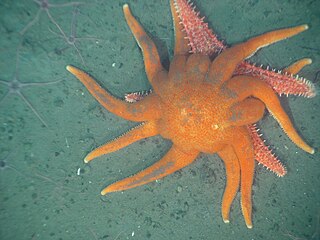
The Valvatida are an order of starfish in the class Asteroidea, which contains 695 species in 172 genera in 17 families.

Solaster paxillatus, the orange sun star, is a species of starfish found at varying depths in the northern Pacific Ocean. It is a natural predator of the starfish Asterias amurensis.
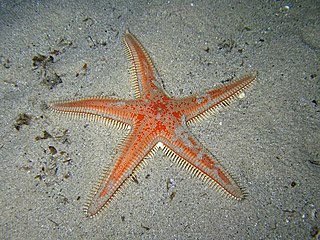
Astropecten aranciacus, the red comb star, is a sea star of the family Astropectinidae. It is native to the east Atlantic Ocean and the Mediterranean Sea.

Cucumaria miniata is a species of sea cucumber. It is commonly known as the orange sea cucumber or red sea cucumber due to its striking color. This northeast Pacific species is often found wedged in between rocks or crevices at the coast or on docks and can generally be identified by its orange bushy tentacles protruding above the substrate.

The leather star is a sea star in the family Asteropseidae found at depths to 100 m (328 ft) off the western seaboard of North America. It was first described to science by Adolph Eduard Grube in 1857.

Certonardoa semiregularis is a species of sea star in the family Ophidiasteridae. It is the only species in the genus Certonardoa.
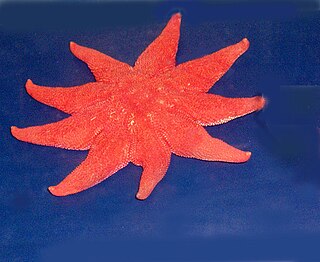
Solaster is a genus of sea stars in the family Solasteridae.

The Solasteridae are a family of sea stars.

Solaster dawsoni, the morning sun star, is a species of starfish in the family Solasteridae. It is found on either side of the northern Pacific Ocean. It has two subspecies:

The purple sunstar, northern sunstar, or smooth sun star, Solaster endeca, is a species of starfish in the family Solasteridae.

Evasterias troschelii is a species of starfish in the family Asteriidae. Its common names include the mottled star, false ochre sea star and Troschel's true star. It is found in Kamchatka and the north western coast of North America.
Stylasterias is a genus of starfish in the family Asteriidae. Stylasterias forreri, the velcro star, is the only species in the genus. It is found on the Pacific coast of Canada and the United States.
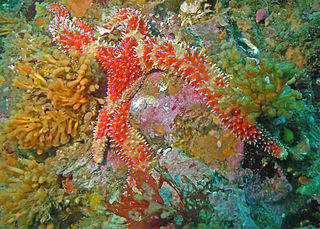
Orthasterias is a genus of sea stars in the family Asteriidae. Orthasterias koehleri, the rainbow star or red-banded sea star, is the only species in the genus. It is found in the North Pacific Ocean.

Hippasteria is one of 70 genera of sea stars in the diverse family Goniasteridae.

The Freyellidae are a family of deep-sea-dwelling starfish. It is one of two families in the order Brisingida. The majority of species in this family are found in Antarctic waters and near Australia. Other species have been found near New Zealand and the United States.
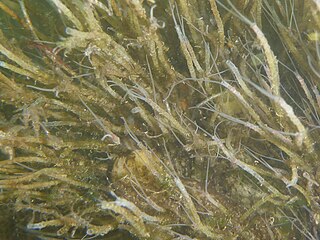
Phyllochaetopterus prolifica is a species of marine polychaete worms that live in a tube that it constructs. It is native to shallow waters in the eastern Pacific Ocean and forms colonies of tubes on rocks and submerged objects.

Astrolirus patricki is a species of starfish in the family Brisingidae. It is a deep-sea species found on seamounts in the northwestern Pacific Ocean, at a depth of between 1,458–2,125 metres (4,783–6,972 ft).

Solaster namakae is a species of starfish within the family Solasteridae. The species occurs off the Hawaiian Islands at depths of 1169 to 1979 meters. The species name namakae is named after Nāmaka, the Hawaiian goddess of the ocean. It has eight arms with a thick dermis, covering the starfishes surface. The color of the body can vary from white to dark orange.



















